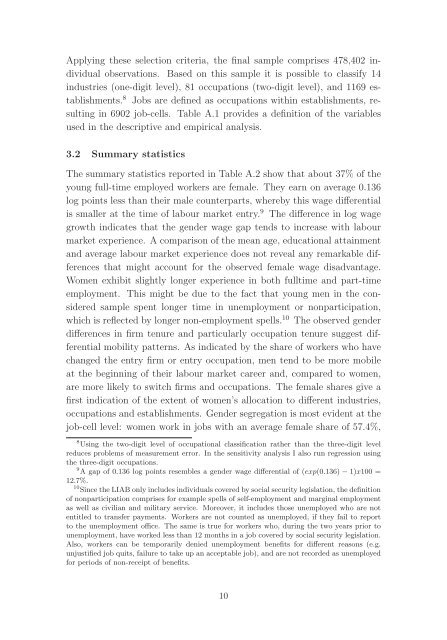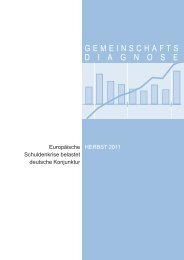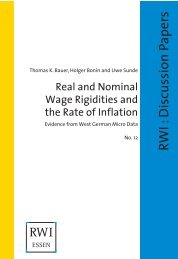Gender Segregation and Gender Wage Differences during the Early ...
Gender Segregation and Gender Wage Differences during the Early ...
Gender Segregation and Gender Wage Differences during the Early ...
Create successful ePaper yourself
Turn your PDF publications into a flip-book with our unique Google optimized e-Paper software.
Applying <strong>the</strong>se selection criteria, <strong>the</strong> final sample comprises 478,402 individual<br />
observations. Based on this sample it is possible to classify 14<br />
industries (one-digit level), 81 occupations (two-digit level), <strong>and</strong> 1169 establishments.<br />
8 Jobs are defined as occupations within establishments, resulting<br />
in 6902 job-cells. Table A.1 provides a definition of <strong>the</strong> variables<br />
used in <strong>the</strong> descriptive <strong>and</strong> empirical analysis.<br />
3.2 Summary statistics<br />
The summary statistics reported in Table A.2 show that about 37% of <strong>the</strong><br />
young full-time employed workers are female. They earn on average 0.136<br />
log points less than <strong>the</strong>ir male counterparts, whereby this wage differential<br />
is smaller at <strong>the</strong> time of labour market entry. 9 The difference in log wage<br />
growth indicates that <strong>the</strong> gender wage gap tends to increase with labour<br />
market experience. A comparison of <strong>the</strong> mean age, educational attainment<br />
<strong>and</strong> average labour market experience does not reveal any remarkable differences<br />
that might account for <strong>the</strong> observed female wage disadvantage.<br />
Women exhibit slightly longer experience in both fulltime <strong>and</strong> part-time<br />
employment. This might be due to <strong>the</strong> fact that young men in <strong>the</strong> considered<br />
sample spent longer time in unemployment or nonparticipation,<br />
which is reflected by longer non-employment spells. 10 The observed gender<br />
differences in firm tenure <strong>and</strong> particularly occupation tenure suggest differential<br />
mobility patterns. As indicated by <strong>the</strong> share of workers who have<br />
changed <strong>the</strong> entry firm or entry occupation, men tend to be more mobile<br />
at <strong>the</strong> beginning of <strong>the</strong>ir labour market career <strong>and</strong>, compared to women,<br />
are more likely to switch firms <strong>and</strong> occupations. The female shares give a<br />
first indication of <strong>the</strong> extent of women’s allocation to different industries,<br />
occupations <strong>and</strong> establishments. <strong>Gender</strong> segregation is most evident at <strong>the</strong><br />
job-cell level: women work in jobs with an average female share of 57.4%,<br />
8 Using <strong>the</strong> two-digit level of occupational classification ra<strong>the</strong>r than <strong>the</strong> three-digit level<br />
reduces problems of measurement error. In <strong>the</strong> sensitivity analysis I also run regression using<br />
<strong>the</strong> three-digit occupations.<br />
9 A gap of 0.136 log points resembles a gender wage differential of (exp(0.136) − 1)x100 =<br />
12.7%.<br />
10 Since <strong>the</strong> LIAB only includes individuals covered by social security legislation, <strong>the</strong> definition<br />
of nonparticipation comprises for example spells of self-employment <strong>and</strong> marginal employment<br />
as well as civilian <strong>and</strong> military service. Moreover, it includes those unemployed who are not<br />
entitled to transfer payments. Workers are not counted as unemployed, if <strong>the</strong>y fail to report<br />
to <strong>the</strong> unemployment office. The same is true for workers who, <strong>during</strong> <strong>the</strong> two years prior to<br />
unemployment, have worked less than 12 months in a job covered by social security legislation.<br />
Also, workers can be temporarily denied unemployment benefits for different reasons (e.g.<br />
unjustified job quits, failure to take up an acceptable job), <strong>and</strong> are not recorded as unemployed<br />
for periods of non-receipt of benefits.<br />
10
















